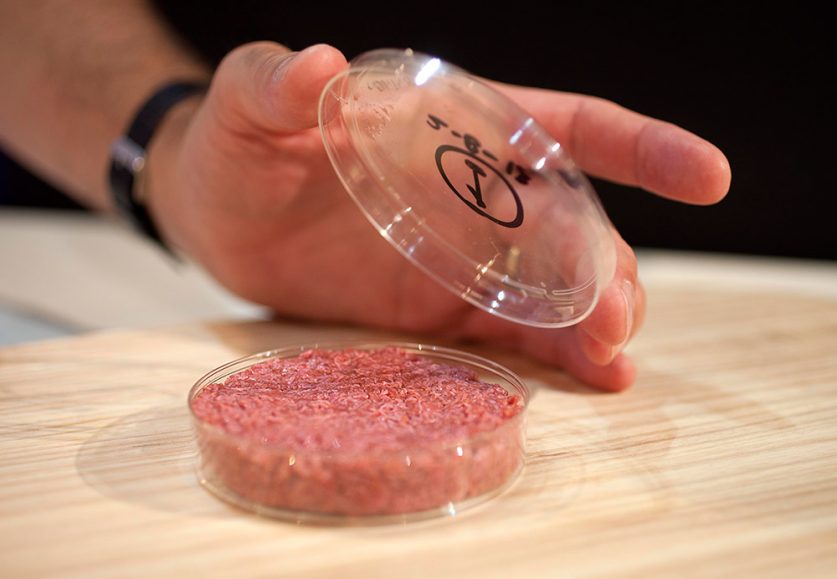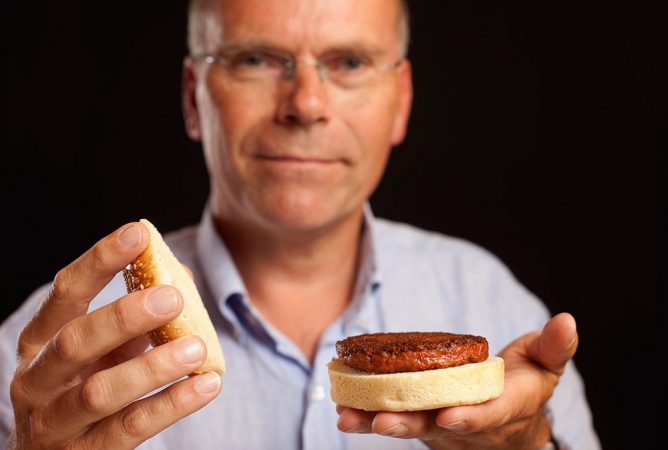Meet the new meat
Scientists made a hamburger without harming animals; but it cost as much as a house

Scientists created a hamburger patty using beef grown in a lab. No animal gave its life to produce this meat.
David Parry / PA Wire
On August 15, two food tasters joined a chef and a scientist on a stage in London before a live TV audience. Asked to rate a hamburger, they sniffed, tasted, then chewed bits of the meat. Afterward, they gave this burger — yes, the one burger they shared — a thumbs-up. In the mouth, it felt like normal ground meat, they said. And though its taste was less than ideal, they concluded that the patty certainly resembled ground beef. Such comments actually constituted high praise. The reason: This was no ordinary beef.
Conventional beef is muscle tissue harvested from a slaughtered cow. But no animal gave its life for this meat. Instead, scientists at Maastricht University in the Netherlands spent the last five years fine-tuning methods to grow muscle tissue in a dish. Mark Post, the lead scientist behind the new burger, refers to his culinary creation as “cultured beef.”
Post’s team started with stem cells. These special cells multiply rapidly and can differentiate into nearly any type of cell. Post harvested his starting cells from a cow. Using a needle, he removed some muscle stem cells from a living cow. (These cells ordinarily replace lost or damaged muscle tissue to help an animal heal.) In the lab, Post fed those cells so that they would multiply, producing millions more muscle cells.
Over time, these cells can be formed into strips. But they’re small. The scientists needed 20,000 strips to create just one patty. Then, to make it better resemble ground beef, they added bread crumbs for texture and beet juice for coloring.
Hanni Rützler was one of the two people invited to sample the cultured burger. She thoughtfully sniffed and chewed her bite. “There is quite some intense taste, and it’s close to meat,” concluded this nutrition scientist, based in Vienna, Austria. She added, however, “It’s not that juicy.” The other taster, American food journalist Josh Schonwald, similarly concluded that the burger came close to the real thing.

Such an assessment was “more positive than I expected,” Post told Science News for Kids. “We had tasted it before and found it to be satisfying, but not yet perfect.” The tasters’ response gave him some ideas for how to improve the recipe, he added.
Wonder what it tastes like now? Get ready for a long wait. Computer scientist Sergey Brin, who cofounded Google, funded Post’s work on cultured beef. Post’s quest for the first lab-grown burger came with a hefty price tag — more than $300,000. But the lone burger it yielded was worth it, Brin said in a video that aired with the burger tasting.
As weird as lab-grown meat may sound, he and physiologists like Post see its development as one way to plan for the future. A 2011 United Nations study predicted a dramatic increase in the worldwide demand for meat in the next 40 years. But raising animals like cows will require using large swaths of land and devoting enormous quantities of crops to feed the animals. In addition, those animals produce methane — a colorless greenhouse gas that contributes to global warming.
Cultured beef may meet the growing worldwide demand for meat without raising and slaughtering livestock, explains Post.
The August 15 demonstration showed the technology exists. But don’t go looking for cultured beef in the supermarket just yet. Post says scientists still need to design new technologies to mass-produce and process the meat. But they’re off to a good start, and Post says he hopes that within 20 years, cultured beef will be affordable and widely available.
And maybe enticing. After the televised event, more than 60 percent of polled viewers in the United Kingdom and the Netherlands said they’d be willing to try cultured beef.
“Some people think this is science fiction.” Brin says. “I actually think that’s a good thing.” He argues: “If what you’re doing is not seen by some people as science fiction, it’s probably not transformative enough.”
Power Words
differentiate The process by which a cell becomes a specific cell that can serve a particular purpose, such as when a stem cell becomes a muscle cell.
physiology The branch of biology that deals with the everyday functions of living organisms and how their parts function.
stem cell A “blank slate” cell that can give rise to other types of cells in the body. Stem cells play an important role in tissue regeneration and repair.
greenhouse gas A gas that contributes to the greenhouse effect by absorbing heat. Carbon dioxide is one example of a greenhouse gas.
transformative Bringing about or capable of bringing about dramatic change.







